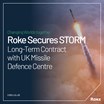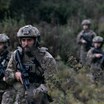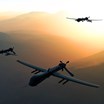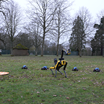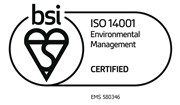
Defence technology 2025: AI, robotics & innovation in a shifting global Llandscape
Defence technology is evolving at pace, driven by the need for agility, innovation, and competitive edge. Combine this with geopolitical tensions rising and military operations becoming more complex, and you understand that defence forces need cutting-edge technology to stay ahead.
Industry is eagerly awaiting the findings of this year’s expected Strategic Defence Review, and while Wednesday’s speech from Chancellor of the Exchequer, Rachel Reeves did not directly go into details on the UK’s defence budget, her pledge to build "Europe's Silicon Valley" between Oxford and Cambridge certainly suggest that technology development is a key goal. Combine this with ongoing debates in Westminster over the role SMEs can play in accelerating UK military capabilities, and it’s clear that defence innovation and procurement is square in the sights of the Government and across industry.
Data-driven warfare, the integration of robotics, further adoption of AI – all will see 2025 as the new frontier for how modern battles are fought and won.
Here are the key trends that will shape defence technology in the year ahead.
Data and power as core battlefield assets War Dev, and revitalisation
Data and power will continue to be the backbone of military operations, with an increasing focus on enhancing connectivity and energy efficiency. The battlefield is not just about weapons – you need seamless movement of information, as well as energy sources that sustain troops, vehicles, and communication systems. Militaries must develop new ways to power soldiers, supply chains, and platforms in austere environments where traditional energy sources are unreliable. Data and power are intrinsically linked: efficient power solutions enable real-time data transfer, while smart data analytics help optimise energy use on the battlefield.
Optimisation isn’t just relevant here either. Taking inspiration from the world of software development, the "War Dev" approach is changing how defence technologies are created and deployed. Not unlike agile software development, this method means rapid iteration, quick adaptation, and frequent re-deployment of new technologies.
A modular and iterative approach to innovation allows defence forces to react quickly to emerging threats – look at Ukraine – with new technologies that can be tested, refined, and deployed with unprecedented speed.
This means that as defence budgets are under strain, the defence enterprise can increasingly look at the potential of legacy technologies to fill capability gaps. High-frequency (HF) communication systems, acoustic sensors, and other "shelved" technologies can be repurposed. Unlike new and untested innovations these systems are already proven, making them attractive solutions for cash-strapped governments looking for cost-effective upgrades. I’d expect to see a resurgence of these older technologies, reengineered with modern enhancements. The potential to provide immediate and reliable solutions to today’s challenges is high.
Expanded civilian applications of military tech but geopolitics driving defence investment
The crossover between military and civilian technology is set to increase if only because governments want more value for money – and rightly so. But we believe defence innovations will also be repurposed for industries such as mining, utilities, and infrastructure. The focus will be on solving real-world problems rather than simply finding “dual-use” applications for defence tech. Advanced sensors, AI-driven automation, and secure communications originally designed for defence are being integrated into civilian markets, yes, but they’re leading to increased efficiency and resilience in commercial sectors because of the recognition that defence technology can provide solutions beyond the battlefield.
This said, rising tensions involving Russia, China, and other geopolitical actors, means that nations are ramping up defence spending and placing more importance on innovation. Because of this uncertainty – governments and defence contractors need to be ready for rapid, unpredictable shifts in global security. This will only drive further investment in flexible and scalable defence solutions. Think next-generation surveillance systems and adaptable battlefield networks that respond to evolving threats in real time.
Integration of AI in tactical operations, supply chain resilience, and information warfare
Artificial intelligence (AI) is set to become an even more critical component of military decision-making. The challenge, however, lies not in developing AI but in creating ethical systems that align with the legal frameworks of different operating environments. AI must be able to adjust to the laws and combat rules of each region while maintaining operational effectiveness. We anticipate that the coming year, and beyond, will see an increased focus on refining AI, ensuring powerful tools are compliant with international regulations.
This adaptation will be coupled with governmental changes to procurement and supply chain management. Unlike major defence primes, SMEs operate with thinner margins and shorter order books that are more vulnerable to market fluctuations.
Governments will create and provide clearer and more consistent demand signals to protect sovereign defence industries. Without this proactive intervention, we really see some of the most innovative players in the sector may struggle to survive.
Equally, adaptation to information warfare will be a necessity, and no longer an emerging trend. The ability to discern truthful narratives, conduct cyber operations, and leverage social sentiment analysis increasingly important and influential. Governments and military forces must develop clear ethical frameworks – combined with AI – for all operations, but especially when they involve civilian populations. AI-powered misinformation campaigns and deepfake technology will make distinguishing between truth and deception more difficult, but AI can and will also be used throughout 2025 to refine that truth from deception.
Expansion of robotics in military applications a year of innovation and adaptation
While I’d love to see Hollywood-style humanoid robots on the battlefield, the real growth in military robotics will come from modular, autonomous systems. Swarm drones, autonomous logistics vehicles, AI-driven surveillance platforms: they’re already here, and will continue to evolve throughout 2025, providing force multipliers in combat and support roles. These robotic systems will enhance lethality, efficiency, and survivability by combining AI with legacy technologies, maximising effectiveness while minimising risk to human soldiers. This will only grow in importance, and is something we’re well versed in at Roke.
Finally, I’d really not be surprised in the slightest if the key themes for 2025 emerge as agility, cost-effectiveness, and resilience. Defence and government personnel alongside defence contractors simply need to be able to navigate shifting geopolitical landscapes while balancing innovation and budget constraints – a difficult prospect. But whether through AI integration, revitalising legacy systems, or fostering cross-sector collaboration, we believe that it can be done, Roke boasts many people who have the skills and capabilities to conduct exactly that. This year we can see them coming into their own, and owning the narrative of rapid adaptation to emerging threats and opportunities.

Get in touch
Can we accelerate your competitiveness in the modern battlefield? Get in touch today:
Related news, insights and innovations
Find out more about our cutting-edge expertise.


